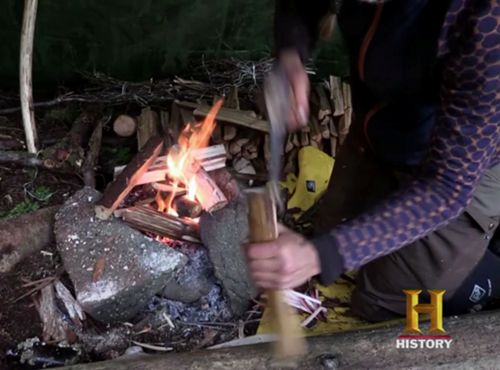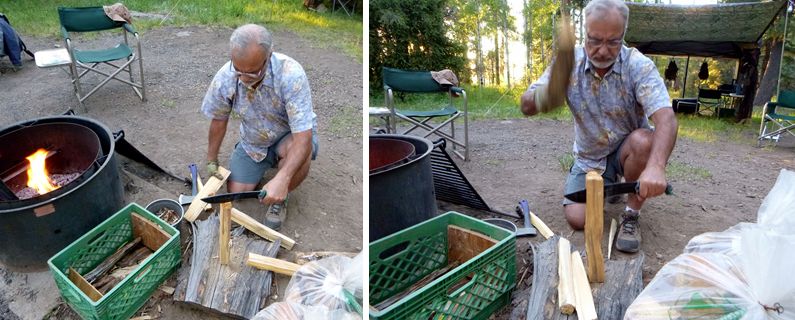
| Articles | Documents | Equipment | Events | Links | Membership | Miscellaneous | Scrapbook | Targets | What's New |
|
Bladeology Safe Splitting | August 2016 | ||
| Dan Martinez
| |||
|
This is a screen grab from Episode 2, Season 2 of History Channelís hit survival
show, Alone. If you are not familiar with the show, 10 people are chosen to be
dropped off in the wilderness with a very limited set of gear. Their goal is to
live off the land and their wits for as long as they can. They each have an
emergency GPS device with them, plus camera gear so that they can film themselves
for the show. When they can no longer face another day in the bush Alone, all
they have to do is push the button and a crew will race out to pick them up and
take them home. The person who lasts the longest is the winner of $500,000.
Both Season 1 and Season 2 are set on Vancouver Island. This woman, Mary Kate,
is building a cooking fire, splitting wood for kindling using an axe. The blur
you see is the axe glancing off the side of the piece of wood, about to make a
very deep cut in her hand near her thumb joint.
When I saw what she was about to do, I cringed greatly, for I knew what was about
to happen as soon as she wrapped her hand around the piece of wood. She ended up
severing the tendon to her thumb. She describes how the surgeon ďhad to go fishingĒ
for the cut end of the tendon to re-attach it.
How did I know? Iíve done it. Thankfully, not to the depth that Mary Kate cut
herself, but more than once, Iíve sliced myself swinging an axe to split wood. It
is so tempting to be lazy Ė to try to hold the wood with your non-axe hand, trying
to balance the piece vertically, attempting to hit it before it falls over.
Iíve had enough minor slices now, that the alarm bells start ringing pretty loudly
in my head whenever I start thinking about trying to hold that piece of wood.
Also notice that the splitting is not happening directly on the ground, but instead
on top of another piece of wood, in this case a large plank. Mary Kate had that
right at least, sort of.
Notice that she is splitting on top of the rounded surface of a log. You really want
to do your splitting on a flat topped wood surface to minimize the chances that the
bottom of the piece you are splitting will slide off at exactly the right (wrong) time.
A flat-topped stump is ideal for your chopping block or splitting ďanvilĒ.
The purpose of the splitting anvil is less about safety than it is about preserving
the sharp edge of your axe. An axe edge that hits the ground will not keep a sharp
edge for very long.
When you are chopping or splitting on a chopping block, place the piece of wood that
you are chopping on the far edge of the block away from you. That way misses are more
likely to go into the block and not into your foot.
I shouldnít have to say this, but I will: Donít try to steady the piece of wood that
you are chopping by placing your foot on it. Donít. Just donít.
Get yourself down to the level of the wood you are trying to split. Kneel or crouch.
Donít swing your hatchet into a piece of wood that is sitting at ground level, from a
standing position. Again, think about where that sharp edge will go in the case of a
miss. If you are standing, an errant swing is much more likely to come swinging back
in the direction of your leg. If you are down at the level of the wood, the hatchet
is much more likely to stay in a generally horizontal orientation and go into the
chopping block in case of a miss.
If there are other folks around, shoosh them away Ė at least twice the distance of your
arm plus the length of the axe. If you are watching someone else split or chop, keep
yourself away from that swinging edge. Donít try to help the axeman other than by
giving safe chopping advice.
Most in my audience arenít lumberjacks, nor are we building log cabins. Therefore most
of us donít have a need for anything larger than a hand axe or hatchet. Most of the
time, if I need to cut wood larger than a hatchet can take care of, I will grab a saw.
Iím sure that youíve heard the advice before, that a sharp tool is a safe tool, because
you will need to apply less force to make it work. I keep my hatchets sharp enough to
slice paper.
Here are some photos of me demonstrating another safe splitting technique. This is
known as ďbatoningĒ a knife. I actually prefer to split wood using the batoning
technique over using a hatchet to make kindling. Batoning requires the use of a very
sturdy, relatively large, full tang knife. The knife I am using here is a Kershaw
Camp 10.
Itís called the Camp 10 because the blade is 10 inches long. Kershaw has two others
in this series, the Camp 14 and the Camp 18. You might tend to think of these Kershaws
as machetes, but you would be wrong. The blade of my Camp 10 measures .20Ē thick at the
spine. A typical machete measures .08Ē, less than half that. The Camp 10 is a hefty
chunk of carbon tool steel.
Full tang means that the steel of the blade carries through the full profile of the
handle. Batoning is rough duty for a knife, and full tang is the strongest construction.
Batoning allows you to use the knife itself as the vertical stabilizer for the piece
being split. The sharp edge is not swung. Instead you smack the back of the blade with
another chunk of wood. This is the ďbatonĒ. The long blade allows enough to stick out
of the wood to hit, once the blade has been driven into the wood. The thick profile of
the blade along with full tang construction, means you donít have to worry about breaking
the knife.
It is likely that your baton will be rather rough, so remember to wear gloves to protect
your hands. Do you need to ask me how I know? Yeah, I didnít think so.
Thereís enough weight in the Camp 10 to use it as an effective substitute for a hatchet
for many light-duty chopping jobs as well.
The batoning technique can also be used with an axe or hatchet. It is especially useful
when you are trying to split smaller pieces, using a knife.
For many of us, the camping experience isnít complete without a good campfire. In the
West in the dry season, maybe you wonít be allowed to have a campfire due to forest fire
concerns. But as you can see, there are other campfire dangers that can turn a good time
into a very bad one in the blink of an eye. Keep safety at the top of your mind whenever
you pick up a sharp piece of steel.
| |||
| If you enjoyed this story, or found it useful, please consider clicking here to join the NRA at a discount of $15 off the normal membership cost. You will be supporting both this website and adding your voice in support of the Second Amendment. Thank you very much. |

|

|
|


